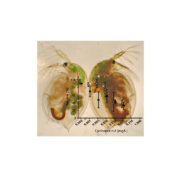Characterization, communication and minimization of risks originating from emerging contaminants and pathogens in the water cycle (TransRisk)
The presence of emerging contaminants and pathogens in the water cycle may pose a risk to humans and the environment. It is known that municipal wastewater treatment plants currently cannot remove all pathogens and anthropogenic micropollutants such as drug residues, cosmetics, or additives of food and industrial products from the wastewater. Advanced treatment methods such […]

 L. Schlüter-Vorberg
L. Schlüter-Vorberg







